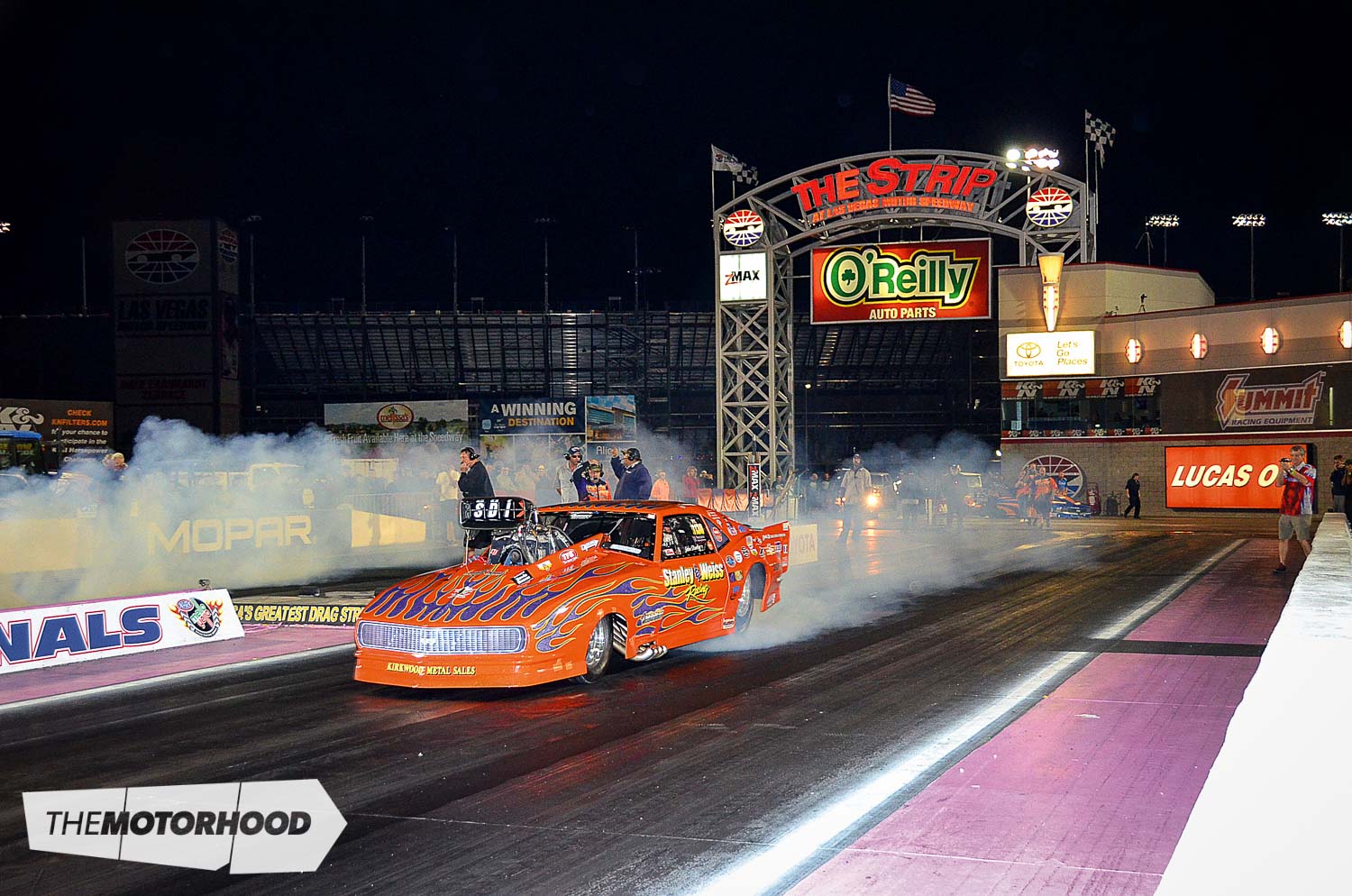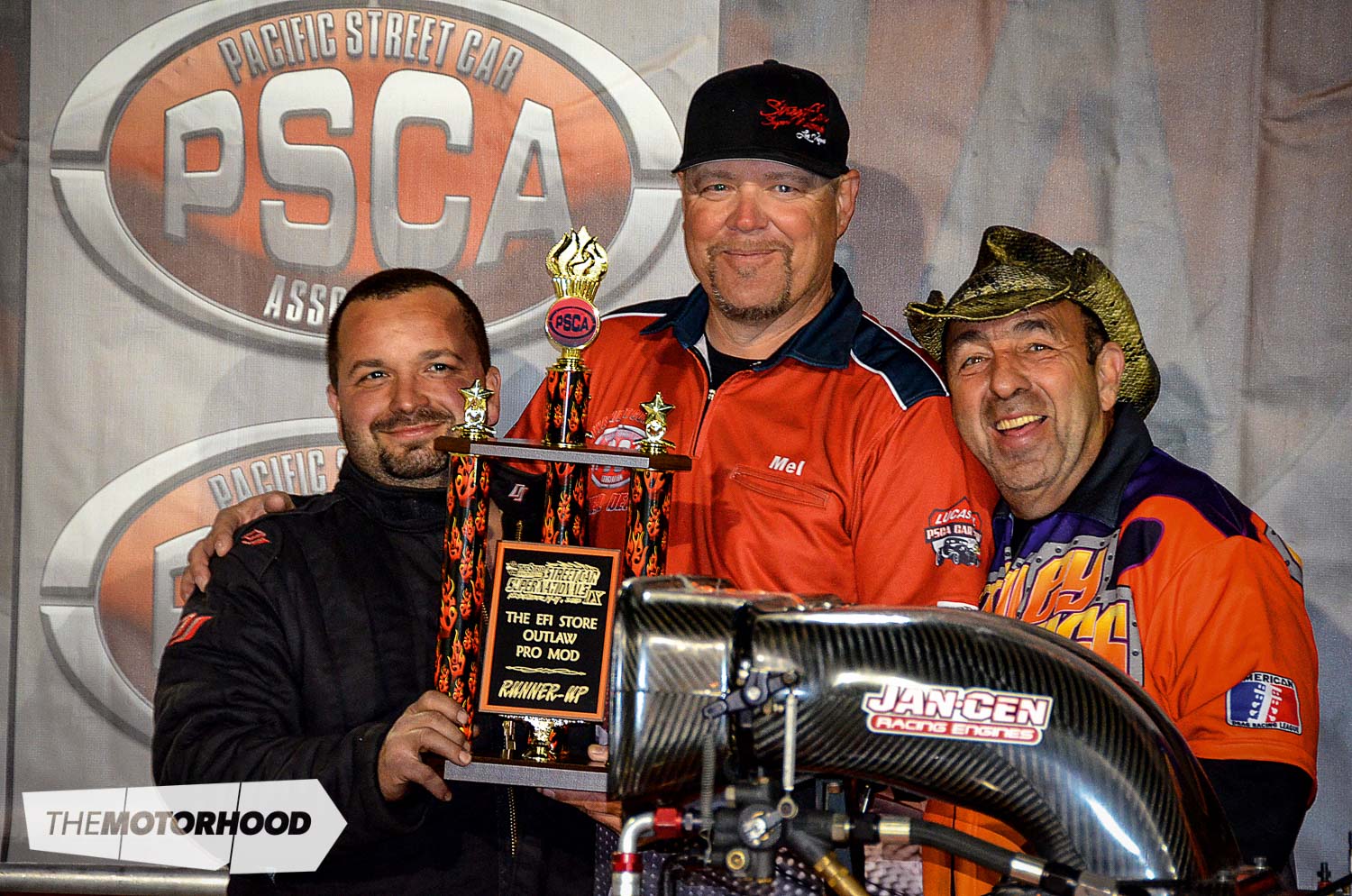
data-animation-override>
“Last month, we talked about drag-racing legend Camp Stanley and his Kiwi connections as a background to his recent exploits as owner and tuner of the fastest door-car in the world …”
The Stanley and Weiss team had become immersed more and more deeply in the ultra-competitive world of eighth-mile drag racing since 2007, but, during 2013, Camp began hankering for a shot at the full quarter-mile again. Having been, for 40 or so years, one of the first to push a door-car into the eights, then the sevens, and then the sixes, there was a line on his bucket list — subconsciously, at least — that hadn’t been crossed out. While Camp; his son, John, and his partner, Axle Weiss (racing partner, that is; he’s not ‘camp’, remember!) had been running the orange Camaro in the American Drag Racing League (ADRL) eighth-mile series, door-cars in his old quarter-mile world had been dropping into the five-second zone, and this was an itch that Camp really needed to scratch. And not just for himself; he also wanted his son and hot-shoe driver, John Stanley, to have a five-second quarter-mile timecard to hang on his wall before they all pulled the plug.

A life event that has been sneaking up on Camp is a birthday with a zero in it — 70, to be precise. Despite still having the heart and the mind to act like a guy half his age (actually, a quarter his age, a lot of the time), Camp’s smart enough to know that his current health and mobility could change in a heartbeat, so if he wants to get more stuff done — like having a crack at running a five-second pass on the quarter-mile — he’d better get on with it.
Each November, an event called the ‘Street Car Super Nationals’ is held at ‘The Strip’ — part of the Las Vegas Motor Speedway facility. It attracts the heaviest of door-car heavy hitters from all across America, such as 2012 NHRA Pro Modified champion Troy Coughlin, past NHRA US Nationals winner Eric Dillard, and multi-record holder Mike Maggio. The big attraction with the Street Car Super Nationals in Vegas is that it’s about the only place in the US that allows a door-car equipped with a PSI Superchargers screw-type blower to run on a decent quarter-mile track. Because of the huge power that these blowers can help a top-alcohol engine to achieve (between 3000 and 4000 horsepower), most mainstream door-car series, like NHRA Pro Modified — in the interest of keeping the speeds of the short-wheelbase cars loosely within the realms of something approaching sanity — prohibit the use of screw-type blowers. But, like most other things in Vegas, anything goes here.
The ADRL series — in which the Stanley and Weiss team runs — does allow screw-type blowers, and during the six years that Camp and co. have been running the eighth with the ADRL guys, they’ve known full well that within the car’s equipment list and the fertile and experienced mind of Arthur Camp Stanley lies — potentially, at least — one of the fastest quarter-mile door-cars on planet Earth.

Despite the opportunity provided by the Street Car Super Nationals for Camp to cross that ‘run-a-five-second-pass’ line off the bucket list, and no shortage of desire to seize that opportunity, Camp and team had never planned to go. From Hagerstown in Maryland, the round trip to Las Vegas for this team of ordinary guys on wages (or an old-age pension in Camp’s case) represented over 5000 miles, 80 hours behind the wheel of the transporter, a US$4K diesel bill, and eight flights for the team members who couldn’t take two weeks off work to travel. After all of that, of course, could come the potentially stratospheric costs associated with blowing up a lot of expensive shit as they traversed previously uncharted quarter-mile territory in their eighth-mile race car.

That all started to change, however, when the event’s promoter, Mel Roth, began hounding Camp to bring the orange Camaro across. Then, when good sponsor Steel Dynamics, Inc. and Outlaw Pro Mod buddy Dan Myer offered to help out with funding the fuel bill, it was “on like Donkey Kong”, to borrow one of Camp Stanley’s own colourful phrases.
Camp knew full well that there were no guarantees that they would run a five-second pass. It had, after all, been a number of years since John and the Camaro had stretched themselves over a full quarter-mile distance, and what works for an eighth doesn’t necessarily work for a quarter. As many thoughts came and went in Camp’s head during the 40 hours spent traversing seven-eighths of the width of America in his Freightliner transporter, he quietly hoped — expected, perhaps — that his car, his driver, and his experience and knowledge would get them that coveted five-second timecard: fairly confident of a five-ninety-something, a fair chance of a five-eighty-something, and an outside chance of a five-seventy-something.
Leading up to the November 2013 event at The Strip, the benchmark was Dan Nickelson. Earlier in 2013, he had made the fastest pass ever by a car with doors of 5.706. No car on planet Earth fitted with doors had ever run a 5.6-second pass.

Race cars are so sophisticated, so highly evolved these days that improvements in ETs and miles per hour come in tiny increments, and a lot of time goes by waiting for the next barrier to be broken. With Nickelson’s 5.706 in the record books, the biggest thing on the mind of every one of the big league players leading up to that weekend wasn’t to win the event or to set a personal-best time or speed; it was to be the first in the world to break the 5.7-second door-car barrier and run a 5.6-something. A 5.699 would be just fine, thank you very much.
Everyone knew that if the conditions were right at The Strip, there was a pretty decent chance that the job could be done, and someone would become the first in the world to break a barrier and own a new ‘number’. They also knew that it would be many racing years before the next opportunity came along. On Thursday, November 15, race teams from all over the US converged at The Strip, and it was clear that the conditions were conducive to good performances. At the track, racers and fans alike were enveloped by an air of excitement and anticipation. Would it happen? Who would do it? The Coughlins and the Dillards and the Maggios and plenty of other guys all wanted it to be them, to the point that everyone wanted to get into the staging-lane queue ahead of everyone else …
When it was the turn of the Stanley and Weiss team to make its first qualifying pass, a few 5.9s and a couple of 5.8s had been recorded. While others were focused on the magic ‘6’, Camp and team were focused simply on their desire to run a five-second pass. A five-anything to start with would be fantastic.

The first quarter-mile pass in many years for the Stanley and Weiss / Steel Dynamics–backed Camaro went well, and it was a great thrill for John Stanley to be able to keep the power on after the eighth-mile had passed under the car. It looked like a hell of a pass, and it was.
At the start line, the team was elated to see that it was ‘job done’, as the electronic scoreboard flashed up a series of numbers starting with ‘5’. The trip had been worth it already! But it wasn’t just a ‘5’; it was a 5.799 — enough to have the Stanley and Weiss team hoopin’ and hollerin’ on the start line and all the other teams taking notice of the boys from out east. The quickest pass of the session! But then Camp saw it. As the jubilation subsided, Camp took note of the speed section of the electronic scoreboard: 204.66mph. While most of us can only dream about going that fast, by quarter-mile standards, for a car like the orange Camaro, 204 is way slow. That could only mean one thing, and John confirmed over the radio that, yes, there had been a problem. Just past 1000 feet, some fuel had sprayed over the windscreen, and, as John has always done at any sign of trouble, he quickly shut off and pulled the chutes. That was a game changer right there, and Camp knew at that moment that the Stanley and Weiss team had as much of a chance of getting into the record books as anyone else. Maybe more.
As Thursday came to an end, the barrier remained intact, but Eric Dillard had run a so-close 5.706 at over 250 mph. With Dillard only 7/1000ths away, and John Stanley’s early shut-off 5.799, the anticipation for Friday was sky-high.

On Friday morning, pairing after pairing went down the track in a blaze of clutch dust and heat haze, while John sat in the staging lanes anxiously awaiting his turn. By the time the orange Steel Dynamics Camaro rolled to the front of the queue then into the burnout area at 10am, all the big guns had already been and given it their best shot, but the barrier remained. John Stanley’s run was perfection personified, and everyone — fellow racers included — straining to see the electronic scoreboard erupted in jubilation as the numbers came up: 5.648s and 253mph.
Camp, John, Axle, and team members Scott Kline and Jimmy Kline (no relation to each other, believe it or not) had run their five-second pass; they had run the world’s first 5.6-second door-car pass, and they had become — as they remain — the operators of the fastest door-car in the world. At 3pm on that same day, John’s second pass proved it was no fluke, with another ET slip to hang on his wall of an almost identical 5.644, again hitting over 250 mph. A little slice of drag-racing history was made by a bunch of working-class good ol’ boys from the Appalachian Mountains.
Camp looks back on that weekend in November 2013 as possibly the best race weekend of his life. During an email exchange afterwards, I told him that he needed to commemorate the event with some special-edition T-shirts (not a sales pitch, just to clarify; he has an awesome illustrator over there in the US). I said, “I’m not trying to throw water on your fire, but you never know what fate has in store — that might have been your finest hour right there.”
Camp readily agreed, saying, “Yeah, you’re speaking the facts, and I know that. It’s at the top of my accomplishments, for sure.”

So, owner and tuner of the fastest door-car in the world, father of the fastest door-car driver in the world, and 70 years of age in a few months — a perfect time to retire at the top of your game, right? If you know Camp, you’ll be saying “Not a chance”, and you’d be right. As you read this, the finishing touches are being applied to a brand-spanking-new Larry Jeffers–built Cadillac CTS-V Pro Modified coupe — shorter, lighter, less drag, more power. The story of Arthur Camp Stanley the Third ain’t over yet.
Next time you see a funny, noisy, 70-something, five-foot-bugger-all jackhammer helping out one of our guys in the pits here in New Zealand, remember that he’s our honorary Kiwi drag racer and a big-hearted, lovely guy, and go pat him on the back and say, “Good job, buddy”, because that’s exactly what he’d do to you.
This article originally appeared in NZV8 Issue No. 111. You can pick up a print copy or a digital copy of the magazine below:












